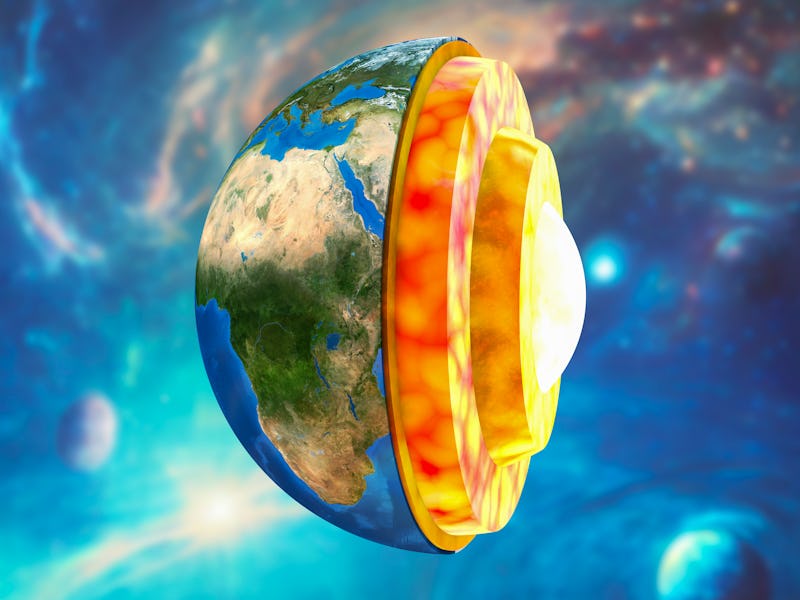Earth's Core Keeps Getting Weirder
A recent study found that our planet's inner core is a mosaic of textures and densities, and maybe some trapped molten metal.

Earth’s core isn’t just a boring, featureless ball of metal, it turns out. A recent study used seismic waves from earthquakes to make a 3D model of the center of our planet, and the researchers discovered that Earth’s inner core is a patchwork of different textures and densities. And there may even still be some liquid iron trapped inside.
The recent study was published in the journal Nature. Seismologist Guanning Pang and his colleagues used a worldwide network of seismic stations, originally built to watch for underground nuclear weapons testing, to watch seismic waves from earthquakes reflect off Earth’s inner core. It took about 2,455 strong earthquakes, measured over about 25 years, before the geologists had mapped enough reflected seismic waves to create a 3D model of our planet’s solid metal heart.
Our comfy little planet was once a fiery ball of molten rock and metal. Because metal is heavier than rock (one of those rare statements that applies to both geology and musical genres), the molten metal sank through the lighter layers of molten rock, eventually ending up in a big ball of iron and nickel at the center of the planet (more or less).
Earth’s core is actually two structures. The innermost layer is as hot as the surface of the Sun, but it’s under such intense pressure that it’s actually solid.
Today, Earth’s core is actually two pieces. There’s an outer layer of molten metal about 1,795 miles thick. Inside that layer of molten metal lies a solid sphere of iron and nickel: the inner core, which is under enough pressure to be a solid despite the tremendous heat. At the center of an ocean of liquid metal, the inner core rotates on its own, like a weird little mini-planet deep inside the Earth. Together, the spinning inner core and the constantly churning outer core turn our planet into a giant electromagnet, powering the magnetic field that protects Earth’s surface from solar winds and deadly radiation.
Earth’s inner core is more complicated than it looks, however. It’s a mosaic of different textures, thanks to iron grains of different sizes and shapes, oriented in different directions. Those textures make up a record of how Earth’s core formed and how it has evolved over time: metals form grains of different sizes depending on how quickly they solidify, so one thing [authors] map tells us is that Earth’s inner core solidified quickly at some points in our planet’s history, and slowly at other points. Pressure, heat, and other factors also reshape those textures over time, which means Earth’s core is still changing and evolving.
In fact, some liquid iron may be trapped and sloshing around inside the otherwise solid core, according to University of Utah seismologist Keith Koper, a co-author of the recent study.
Mapping out those textures, at a resolution of less than 10 kilometers, was no easy feat. It takes an earthquake of around magnitude 5.7 to make seismic waves that can reflect off the core strong enough to be detectable, and even then, the signal is faint.
“The signal that comes back from the inner core is really tiny. The size is about on the order of a nanometer,” says Koper. “What we’re doing is looking for a needle in a haystack. These baby echoes and reflections are very hard to see.”
Eventually, our planet’s patchwork heart could reveal more details about Earth’s early history and the mechanics that drive our all-important magnetic field, without which we would all be dead – or rather, would never have existed at all.